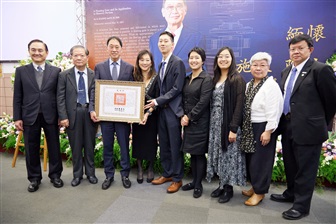Semiconductor legend and scholar Simon Min Sze was commemorated in Taiwan by his students, friends, colleagues, and semiconductor industry celebrities including executives from TSMC, UMC, Macronix, Etron Technology, Phison Technology, etc., in a memorial held at the National Chiao-Tung University (NCTU) on December 28, 2023. More than a hundred people came together to pay their condolences to the Sze family and celebrate the extraordinary life of Simon Sze and his influence on them.
NCTU president Lin Chi-hung presented an honorary citation furnished by the President's Office, a government recognition of those with exemplary contributions to the country.
Sze was best known for inventing the floating-gate MOSFET with Korean electrical engineer Dawon Kahng in 1967, which was the basis of EPROM, E²PROM, and nearly all flash memory before the advent of 3D NAND. He passed away on November 7 in California and was dearly missed by his loved ones.
While working at Bell Labs in the United States, Sze gave lectures in Taiwan five times. National Chiao Tung University (now Yangming Chiao Tung University) awarded him the honor of a lifetime appointment as a distinguished professor. Many of his students were inspired by him to devote their work to semiconductor research and development and later became innovators, entrepreneurs, and company executives.
Sze applied for a leave of absence and agreed to take half-pay from Bell Labs while he taught at NCTU. At the time, there were no well-organized textbooks for semiconductors. Sze spent that year completing and subsequently proofreading and editing his seminal work "Physics of Semiconductor Devices" after work. It became the semiconductor "bible" that is used by university professors all over the world.
However, when he first taught at Chiao Tung University in 1968, the school facilities and living environment were poor. Sze rode an old bike to work and took his children to school. His wife took a photo of Sze and his son and daughter on a bicycle, and they would do so every 10 years to share with their family and friends.

Credit: Sze biography author Wang Li-chuan
Planting the seeds of Taiwan's semiconductor industry
Nicky Lu, chairman and CEO of Etron Technology, said Sze also played a pivotal role in Taiwan's status as a manufacturing hub in global semiconductor supply chains today. Sze and IBM's Bob Evens were among the 7-people Scientific Advisor team whose advice started Taiwan's decision to develop its semiconductor industry. Sze's meeting with Y. S. Sun, the then Minister of Economic Affairs, jumpstarted the later program that sent 19 Taiwanese engineers to RCA for training in 1976.
Shih Chin-Tay, former chairman of the Industrial Technology Research Institute (ITRI), who was among the 19 engineers, recalled that Sze was also the person who helped Taiwan pick the right path when there was yet a technological standard in the semiconductor market.
"If Sze hadn't started the semiconductor education in Taiwan during 1967-1976 and had brought back the latest technology knowledge from the US, how would there be any engineers in Taiwan with enough knowledge to learn from RCA years later? The 10 years of Cze's devotion to semiconductor education planted the seeds of high-tech talent, which built the foundation of Taiwan's semiconductor industry for the next hundred years," said Lu.
Jack Sun and Philip Wong, who both worked at TSMC as CTOs, also attributed Sze as the mentor who had inspired them to pursue their career in the semiconductor industry and chose to challenge themselves to advance the technology with relentless efforts.

Simon Sze (front, left) and Nicky Lu (front, right). Credit: Nicky Lu
Lu describes Sze as an extremely humble, soft-spoken, down-to-earth person who rarely talks about his contributions and achievements. Lu recalled that when he attended the Flash Memory Summit (FMS) in the United States and found that the origin of flash memory was mentioned to have started from Intel and then spread to Japan, he asked the conference to correct the information, because Intel's development began in 1972, 5 years later than Sze and his Korean colleague Kahng's discovery of "Floating Gate Memory" in 1967. Therefore, FMS awarded Sze the Lifetime Achievement Award the following year and put Sze's picture on the first photo of flash memory's development history.
As a student of Sze, Nicky Lu has kept close contact with Sze for decades. Sze took lightly his achievement in discovering the floating-gate memory effect has any chance of being recognized by the Nobel Physics Prize, said Lu. When Sze learned that he had been ill and may only have two more months to live, he told Lu over the phone that he knew his days were numbered, but he had had a happy and content life and had completed what he was destined to do during his lifetime.
During his 87 years of life, Cze also received honors including IEEE Fellow (1977), J. J. Ebers Award (1991), Academician of Taiwan's Academia Sinica (1994), Member of the US National Academy of Engineering (1995), Foreign Member of the Chinese Academy of Engineering (1998), IEEE celebrated member (2017), The Future Science Prize, China (2021), etc.

Sze family and friends. Credit: DIGITIMES




